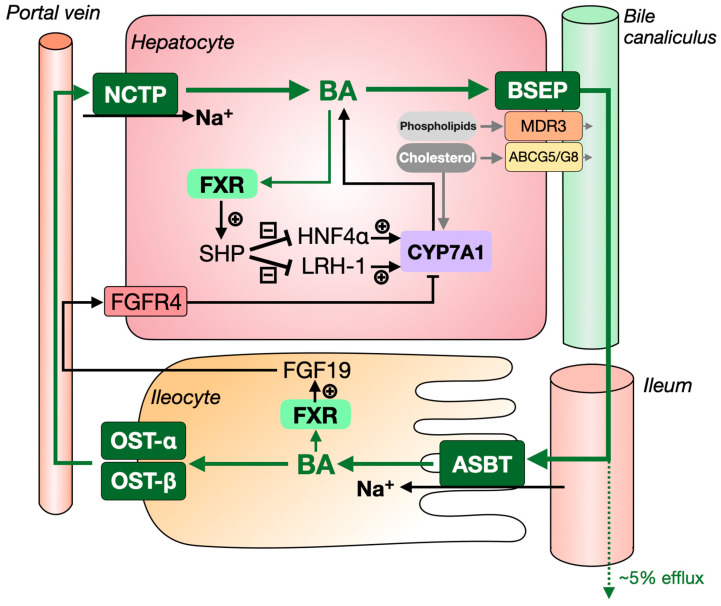Figure 2.
Main transporters of bile acids in the enterohepatic circulation. Once bile acids are synthesized in the liver, they are excreted to the bile canaliculus through the canalicular bile salt export pump, BSEP, and stored in the gall bladder. Phospholipids and cholesterol are transported into the bile by multidrug resistance protein 3 (MDR3) and ATP binding cassette subfamily G member 5/8 (ABCG5/G8), respectively. Bile acids are released into the intestinal lumen upon consumption of a meal to facilitate the digestion and absorption of lipids. In the terminal ileum, approximately 95% of bile acids are reabsorbed, mainly by the apical sodium-dependent bile salt transporter, ASBT. Bile acids are subsequently secreted into the portal circulation by organic solute transporter-α/β, OST-α/β and recycled to the liver, where they are mainly taken up by sodium taurocholate cotransporting polypeptide, NTCP. Bile acids cycle between the liver and intestine ~10 times/day. Each cycle, ~5% of bile acids escapes from reabsorption and is lost in the faeces. Bile acid pool size is maintained by signaling via the farnesoid X receptor (FXR), which induces transcription of its target gene small heterodimer partner (SHP). SHP, in turn, inhibits liver receptor homolog 1 (LRH-1) and hepatocyte nuclear factor 4 alpha (HNF4α) to reduce the expression of cytochrome P450 family 7 subfamily A member 1 (CYP7A1), encoding the first and rate-controlling enzyme in the major bile acid synthesis pathway. In addition, activation of FXR in the intestine induces expression of fibroblast growth factor 19 (FGF19), which is secreted into the bloodstream and activates the fibroblast growth factor receptor 4 (FGFR4) and its co-receptor β-klotho on hepatocytes, leading to inhibition of CYP7A1 expression via incompletely elucidated mechanisms.

